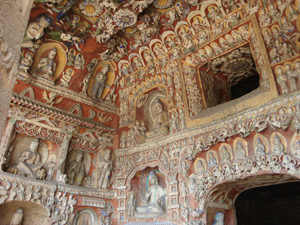Yungang Grottoes: (admission 60 RMB)
|

|
|
Visitors to the Yungang Caves explore their surroundings. [China.org.cn]
|
The bus ride to the grottoes again gave me a place to rest my weary head; I have so become accustomed to sleeping on transportation that it just comes naturally now. I think the ride out of town was about an hour or so, and for 1.5 RMB came at a steal. We took bus 4 to the long distance station and then bus 3-1 out to the grottoes.
I had of course seen pictures of the grottoes in travel pictures from friends and from my own searches on Google, but the sheer size of the Buddhas made the experience seem so surreal. The huge stature of the massive sandstone carvings left us wondering how in the world someone could carve such masterpieces out of sandstone rock, must less envision the whole thing; I myself can only barely color inside the lines.
Walking from left to right we saw the Western Grottoes which were far less crowded and less preserved. The worn hollow faces of the Buddhas often left a haunting feeling in your stomach, some looked more creature than human from the way the elements had deteriorated their faces over time. This was to be expected, it is only the natural property of the sandstone to wear away, especially since the carvings were created over 1500 years ago. The Western Grottoes give visitors an opportunity to get more up close and personal with the Buddhas and look them in the eye (if they still have eyes). The whole experience gives visitors a connection to the past and a shared human experience through generations. I often found myself wondering about the artists and their stories; I wondered what their lives were like, if they had families or not, and what their purpose for working on the caves were. Although this section of the Grottoes is the least preserved, I feel like it has the most stories to share with visitors, a richer history and a more inviting feeling of exploration.
|

|
|
Painted sections have been preserved from wind and rain. [China.org.cn]
|
As visitors begin to find themselves moving away from the Western Grottoes, the big eye catching Buddha in the middle of the complex becomes a veritable smorgasbord for the eyes. This is by far the most photographed section of the Yungang Grottoes and has become an icon for Datong. The massive Buddhas are completely open to the elements due to a cave ceiling collapse long time ago. The facial features remain intact and highly details, it's a natural wonder they look as well as they do. This is only the first of many large Buddhas that finds its home in the complex. The rest are still caved, but most are not as well preserved. From the exterior I found it nice to see the larger Buddhas playing hide and seek with the visitors.
Still moving Eastward, paint begins to appear on the stone carvings. The visitors begin to be able to go inside and feel the cool temperature of the inner earth. The carvings become more detailed and are not just limited to Buddhas. Carvings of different deities and folk tales surrounding their existence are played out on the cool cave walls of the grottoes. But, the piece de resistance of the caves is housed in the large wooden structure built into the side of the mountain. A large golden Buddha with electric blue hair rests atop a carved lotus flower to greet worshipers who enter the cave.
The grottoes gave me a lot to think about. I wondered about the vision for the whole project and why it was constructed. Creating such gargantuan monuments for sake of religion is kind of an exoteric romantic gesture for the appeasement of gods but also the approval of mankind. The people who created these Buddhas did not do so with the hopes of creating a new millennium tourist destination, but a solemn place of worshiping. Yes it is art, yes it is history, but I wonder if this should really be the highly celebrated tourist destination it has turned into. Perhaps my cynicism comes from the vast sea of hawkers visitors have to come through to visit the grottoes and perhaps it too comes from the large amount of people offering souvenir pictures with the Buddhas, but to me it just all seems a little too commerce driven.